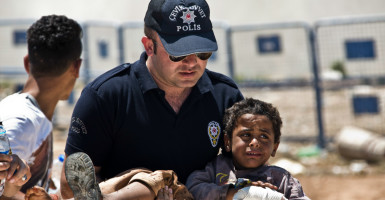Scarred by the Paris terrorist attacks, Republicans are straddling a sensitive line about how welcoming the United States should be to refugees fleeing war and violence in Syria and Iraq.
After passing a bill that halts the admission of refugees to the U.S. from those two countries, some members of the Republican-led House argue that refugees would be better served finding safety closer to home.
“You have a whole area of western Syria that you could actually quarantine off and say, ‘Here, listen, people who want a peaceful existence can actually stay and not be assaulted,’”said Rep. Paul Gosar, R-Ariz. “A lot of refugees want to go home. They want to be a part of that culture. That’s where they’re from, and we ought to be honoring that. We shouldn’t be making it worse.”
In interviews with The Daily Signal, Gosar, along with conservative colleagues Reps. Raúl Labrador of Idaho and Dave Brat of Virginia, endorsed the idea of creating a so-called safe zone in Syria to shield civilians fleeing the nation’s civil war by keeping them in a protected space.
But according to foreign policy experts interviewed by The Daily Signal, even if the U.S. and its international coalition were to impose new policies meant to keep refugees in the Middle East, such as establishing no-fly zones and safe havens in Syria, it would have little impact.
These experts say the idea of carving out parts of Syria to keep and hold vulnerable civilians makes for an easy political proposal, but the process of actually enforcing such zones would be complex and costly and require the U.S. to wade deeper militarily in the Middle East.
“If you want to establish a safe zone big enough and safe enough, it would be a massive undertaking that people don’t appreciate,” said Karl Mueller, a policy analyst at the RAND Corporation and an expert on the use of air power and no-fly zones. “It would represent a major escalation of Western involvement in the Syrian civil war, and I don’t think people should expect it to have a large impact on the refugee flow.”
According to the New York Times, the growing refugee crisis in Syria and Russia’s intervention in that country have inspired the Obama administration to consider deploying American military forces to establish safe zones for civilians on Syria’s borders with Turkey and Jordan.
The Times says that President Barack Obama has weighed both safe zones set up solely to protect civilians and larger ones that would provide a stage for rebel groups to attack Syrian government forces.
Thus far, Obama has resisted such proposals, because he believes that the significant military forces needed to enforce a safe zone, including aircraft and troops on the ground, would be too costly to justify any potential benefit.
Obama has also rejected the idea of imposing a no-fly zone, which would prevent military aircraft from flying in a designated area and launching attacks.
“Establishing a safe zone is an easy button for politicians trying to mitigate the humanitarian situation, but at the same time, it’s an incremental military escalation that won’t solve anything and only lead to greater U.S. involvement on the ground in a war it doesn’t seem to want to fight,” said Jim Phillips, an expert on the Middle East at The Heritage Foundation.
Indeed, military and foreign policy experts agree that safe zones would be difficult to enforce without large numbers of ground troops and that it would be hard to find forces outside the U.S., such as rebel groups in Syria or troops from Turkey or Jordan, willing and able to contribute.
“A safe zone certainly could be helpful with the refugee problem, but only if it’s handled properly,” said Kenneth M. Pollack, an expert in Middle East political-military affairs and a former CIA analyst now at the Brookings Institution. “There has to be a ground force. Who is that going to be? I don’t know of an opposition group up to the task, and the groups that are willing don’t have the military capability. The Jordanians have no interest. And Turkey—God knows what they would do if their troops were used as the ground force.”
In addition, Pollack says, a safe zone could be quickly overwhelmed, because the number of internally displaced people inside Syria (7.6 million as of July) is nearly double that of the amount of Syrian refugees (around 4.3 million as of this month, mostly fleeing to Turkey, Jordan, and Lebanon).
Another challenge, according to Mueller, would be deciding on the location of a safe zone. For such safe havens to have maximum impact, he says, they would have to be placed in areas closer to the front lines, but that would make them easier targets for the Syrian government and to Russian aircraft.
“The areas around the Turkey and Jordanian borders are easiest to set up and protect from places of fighting because they are areas the Syrian government, and Russians have no incentive to attack,” Mueller said. “If you want to reduce the pressure on Syrians fleeing the country, that means establishing safe zones in areas where they are getting bombed and fighting is going on.”
Defenders of safe zones, such as former Defense Secretary Robert M. Gates and former Secretary of State Condoleezza Rice, argue that a more assertive U.S. approach would deter Russia from causing trouble.
“No-fly zones and safe harbors for populations are not ‘half-baked’ ideas. They worked before (protecting the Kurds for 12 years under Saddam Hussein’s reign of terror) and warrant serious consideration,” said Gates and Rice in a recent Washington Post op-ed.
Conservative lawmakers, meanwhile, insist that if a safe zone won’t work, Gulf Arab countries like Saudi Arabia, the United Arab Emirates, and Qatar should accept Syrian refugees.
“Many refugees have reached the conclusion there is no end in sight to the war,” says Kevin Appleby of the U.S. Conference of Catholic Bishops.
“Why is it that countries that for the most part are rich in natural resources are not taking refugees, especially when their cultures are very similar and their religions are similar or the same?” Labrador said. “There are other ways to deal with the resettlement of refugees, and we don’t have to bring them all to the United States, or any to the United States. We can serve them in their own countries, or nearby.”
While many Syrians would welcome returning to their home country, a refugee expert told The Daily Signal the reality is more complex.
“By and large, refugees want to go home; that is their first choice,” said Kevin Appleby, the director of migration policy at the U.S. Conference of Catholic Bishops, which is the largest refugee resettlement agency in the world. “But refugees also want to return to the life they knew before. This is not the life they knew before. Many refugees have reached the conclusion there is no end in sight to the war.”





























![Syrian-crisis_numbers_UPDATED-151202-v3[1]](http://dailysignal.com/wp-content/uploads/Syrian-crisis_numbers_UPDATED-151202-v31.png)